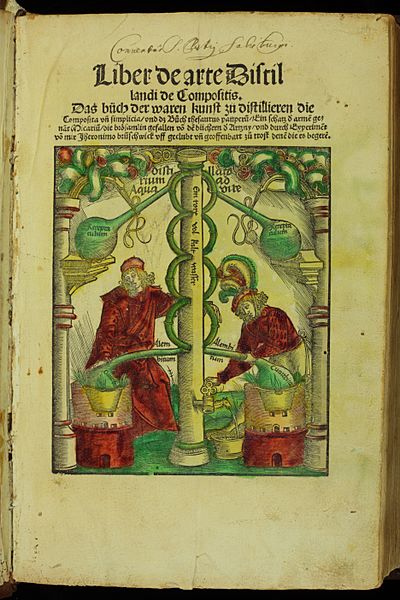Image: Hieronymus Brunschwig Liber de arte Distillandi CHF AQ13x3

Description: Two figures work with one of alchemy’s more grounded practices: distillation. This fanciful depiction of distillation apparatus is from Hieronymus Brunschwig’s Liber de arte Distillandi de Compositis (Strassburg, 1512). Distillation was the technology by which the essence of a sample could be separated from the dross. In its simplest form, the objective of distillation is to separate a mixture of liquid and nonvolatile solids. Since alchemists worked through a sequence of separation and recombination, distillation provided experimental evidence for their view that matter was compounded of earthy and more spirituous constituents. In practice, with the development of the art in the medieval period, alchemists learned to wield distillation apparatus to produce powerful, pure chemicals: alcohol and strong acids (hydrochloric, sulfuric, and nitric). The distinctive apparatus became emblematic of their profession. Brunschwig’s comprehensive book on distillation was one of the earliest devoted exclusively to chemical technology. This work expanded on his smaller, earlier work on distillation of herbal remedies to include a wide range of alchemical distillation techniques. The caption above the apparatus reads: Distillatorium ad Aqua vite, distillation apparatus for aqua vitae, i.e. spirits of wine. Individual pieces of the apparatus are labelled. At the bottom, the cucurbits sit in furnaces with fire issuing from them. The wine contained within them boils, and the vapours rise through a series of pipes to be recondensed and collected in the receivers or Receptacula at the top of the Alembitum. The illustration shown is artistic, rather than functional. As portrayed, the apparatus would be expensive to make and difficult to use. Rising alcohol vapours would be condensed by the "tube full of cold water" Eine rore vol kalt wasser and run back down rather than reaching the receivers.
Title: Hieronymus Brunschwig Liber de arte Distillandi CHF AQ13x3
Credit: Chemical Heritage Foundation
Author: Hieronymus Brunschwig
Permission: This file was provided to Wikimedia Commons by the Chemical Heritage Foundation as part of a cooperation project. کوردیی ناوەندی | English | العربية | Français | Italiano | Македонски | Nederlands | Português | +/− This is a faithful photographic reproduction of a two-dimensional, public domain work of art. The work of art itself is in the public domain for the following reason: This work is in the public domain in its country of origin and other countries and areas where the copyright term is the author's life plus 100 years or less. You must also include a United States public domain tag to indicate why this work is in the public domain in the United States. This file has been identified as being free of known restrictions under copyright law, including all related and neighboring rights. The official position taken by the Wikimedia Foundation is that "faithful reproductions of two-dimensional public domain works of art are public domain". This photographic reproduction is therefore also considered to be in the public domain in the United States. In other jurisdictions, re-use of this content may be restricted; see Reuse of PD-Art photographs for details.
Usage Terms: Public domain
License: Public domain
Attribution Required?: No
Image usage
The following page links to this image:

